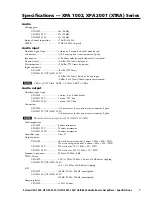
Using Mo' EQ (continued)
Please note that when the Bassynth Filter and Envelope Controls are "open" and the Resonance Control is at the minimum
position, the level of the Bassynth will be higher than the level of the original bass signal, which is normal. However, when
boosting the Mo' EQ Bass Control while the Bassynth is engaged and in that position, that boost will become very dramatic.
Please exercise caution.
Though designed to be a post-effects EQ, there is no reason why you can't use the Mo' EQ as an additional EQ for clean
sounds. In addition to being a different type of EQ (Band Pass vs. shelving/semi-parametric), the Mo' EQ is centered at
much different frequencies (40 hz, 1.5 kHz, 10kHz) than the preamp EQ (80 Hz, variable 200-800 Hz, 2 kHz). The effect is
more subtle, but it can also be the difference between almost what you want and exactly what you want. Try combining both
and see what's best for you.
Chorus
The Mo' Bass Chorus is a warm, analog, very traditional effect. What most people refer to as a "chorus" is, in truth, a
modulated delay.
Chorus Depth Control
This control determines the amount of chorus applied to the original bass signal. When set at minimum ('0'), the delay is
very short, resulting in a very subtle "phasing" effect. As you increase the knob clockwise, the delay time becomes longer
and causes more of a "doubling" sound, making the effect more dramatic.
Chorus Rate Control
This control determines the speed at which the delay time is modulated. When set at minimum ('0'), the Chorus waveform
grows in amplitude and will take over one whole second to complete. As you increase the knob clockwise, the rate of the
Chorus effect will increase. This control also affects the rate at which the yellow LED indicator "glows."
Using The Chorus
To engage the effect, press the chorus switch and the yellow LED should illuminate and "glow" as mentioned above. For a
simple, warm chorus, try setting the Chorus Depth control at '3' and the Chorus Rate control at '2'. To achieve more of a
tremolo effect, set the Rate very high and the Depth very low. You can get a "fattening" effect without sounding like a chorus
if you set the Depth at '10' and the Rate at '0'. For something really weird, turn both controls all the way up and look to see if
the aliens have landed yet.
Using the chorus can greatly enhance the use of harmonics, allowing them to "ring out" better and longer. Clean sounds
can become crystal-clear when both the Mo' EQ and the Chorus are engaged. It enhances the Overdrive and the SubWave
in obvious ways. It also simulate a "third oscillator" when used in conjunction with the Bassynth and the SubWave
simultaneously. As with all of the effects on the Mo' Bass, experimentation is encouraged.
A Final Word On The Mo' Bass Preamp And Effects
It's easy to forget that, with all of the bells and whistles on the front panel, you can still easily achieve a great clean bass
tone. You can also get just about any affected sound you want through various combinations of effects, blends and levels.
But it's important to remember that one thing in the signal path can affect something after it, and that gain levels can
have wide-ranging implications for effects as dynamically sensitive as the effects on the Mo' Bass. Do yourself a favor and
take the time to see what happens to your signal level when you engage and disengage effects BEFORE you get to the gig,
or even the rehearsal.
DUAL MODE
Up until this point, you've operated the Mo' Bass in what we call "Single Channel Mode." In Single Channel Mode the
"single" signal starts at the preamp and goes through all of the Mo' Bass effects. The wet-to-dry ratio of those internal
effects is determined by the position of the two Mix controls (SubWave Mix and Bassynth Mix) in the signal path of the unit.
After the Chorus section (the last Mo' Bass effect in the chain), the signal then is routed to the power amps. At that point,
the power amps can be run in stereo mode or bridged into a mono-block configuration. In Single Channel Mode, both left
and right power amps - whether bridged mono or not - and their respective speaker outputs will see the same signal. Turn
on an effect and it will come out of both sides (if it's mixed in, of course). Turn the effect off and clean bass will come out
both sides. (continued)
9
Содержание Mo' Bass
Страница 1: ...MO BASS OWNER S MANUAL SWR SCOTTSDALE AZ USA...
Страница 37: ...THE DINOSAUR THE DINOSAUR II...
Страница 38: ...IN A MINI MOOD MELLOW DRIVE...
Страница 39: ...BOMB DROPPER COME TOGETHER...
Страница 40: ...ALL SYSTEMS GO SWEET SLAP...
Страница 41: ...WEATHER FORECAST 1 WEATHER FORECAST 2...
Страница 42: ...SONGS IN THE KEY OF MO CHAMELEON...
Страница 43: ...RAGE OVERDRIVE FOLLOW THE ENVELOPE...
Страница 44: ...TOM SAWYER VOODOO PRINCESS...
Страница 45: ...PHASE O MATIC THE ALIENS HAVE LANDED AND THEY RE ANGRY...
















































